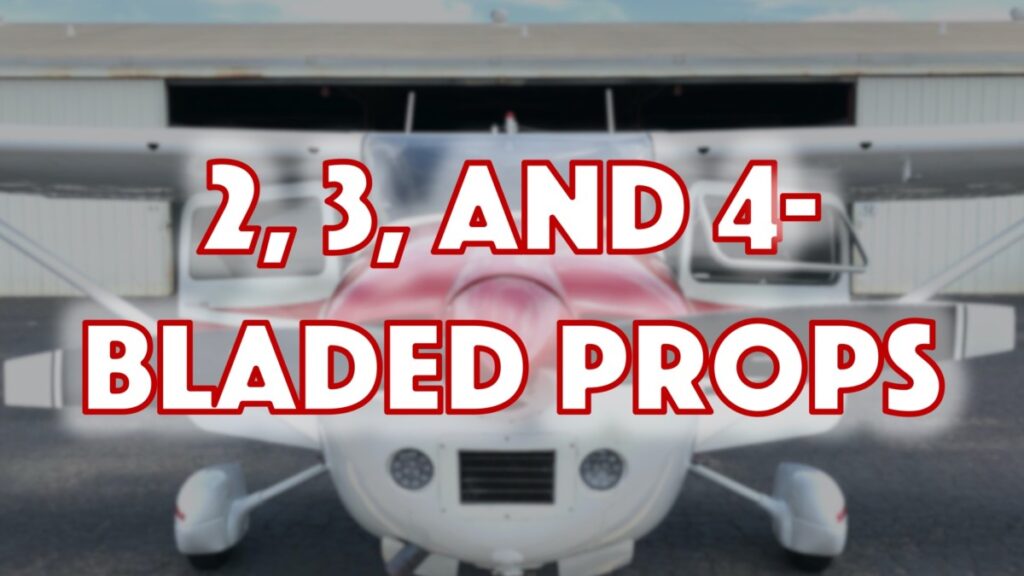
Walk the flight line at any GA airport and you will likely see a mix between 2-bladed and 3-bladed propellers. Some more expensive, high-performance planes may have 4 or more propeller blades.
Besides arguably looking better, there are performance differences to be considered when comparing the blade count of propellers.
What is the difference between 2, 3, and 4-bladed propellers?
Two-bladed propellers are typically used on smaller engines (under 300 horsepower) and are lighter and more efficient. Three-bladed propellers are quieter, have better ground clearance, and create more power but also more drag, and are used on larger engines with enough torque to drive the propeller.
In this article we will discuss these differences, their causes, and what considerations you should make when deciding on what sort of propeller will fit your needs.
How Propellers Generate Thrust
First, let’s discuss how propellers generate thrust in the first place – then we’ll get into the differences in propellers with varying blade counts.
A propeller’s function is to translate the power generated by the engine into useful thrust. Thrust is generated by a propeller in a very similar way as wings generate lift.
Propeller blades and wings are both examples of airfoils. It is helpful to keep this in mind when considering the advantages and disadvantages of 2, 3, or 4-bladed propellers.

As the engine turns, it spins the propeller. As we all learned in primary flight training, an airfoil generates a force when moving through air. A propeller blade generating thrust is analogous to a wing generating lift.
More thrust is a great thing – it helps with take-off, climb, and cruise performance. But much like decisions made when designing a wing, engineers have to make design decisions when deciding what propeller to fit on a plane.
The 2-Bladed Propeller
The efficiency of a propeller describes how much of the engine’s power is directly translated into useful thrust. A higher efficiency means that more thrust is produced with a given horsepower.
Thrust is analogous to lift, and remember- as more lift is generated, drag increases as well, reducing efficiency.
As we increase the number of blades, thrust increases but that means more drag and less efficiency.
Our relatively low-powered general aviation engines don’t have much excess horsepower which is why we typically see 2 blades mounted on our engines. 2-bladed propellers are the most efficient at translating horsepower into thrust.
So, why not just increase the thrust created by a 2-bladed propeller by increasing the length of each blade? It sounds great – you could enjoy the efficiency of 2 blades and get the thrust you want by just increasing the blade length.
It’s a good idea, but there are two primary reasons why you can’t just increase blade length ad infinitum.
First, landing gear can only be so tall and clearance between the propeller and the ground has to be assured.
As the blades get longer, the tips get closer to the ground. At some point when increasing propeller blade length you will run into clearance issues.
My Beechcraft Sierra, for example, has a pretty tall set of landing gear for its size of plane. It has a 76” propeller diameter. In comparison, a Piper Arrow sits closer to the ground and has a 74” propeller.
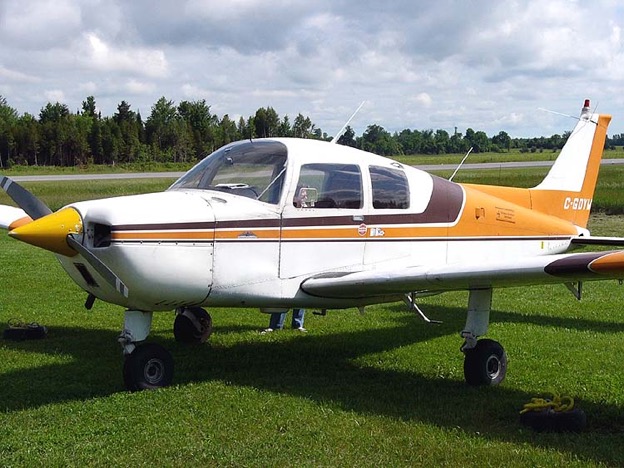
The two aircraft use the same IO-360 engine, both producing 200 horsepower. The Beechcraft Sierra has a much larger (and therefore drag-producing) cabin, but both planes have similar real-world cruise speeds. This is partially due greater thrust produced by the longer propeller on the Beechcraft.
The other limiting factor on propeller length is that the longer the blade is, the faster the tip is spinning.
You may recall that the propeller blade is slightly twisted so that the blade near the hub is at a much greater angle of attack than the tip of the blade. This helps to distribute lift evenly since the blade nearer the hub is spinning at a slower speed than the tip.
As propeller blade tips get close to supersonic speeds, drag increases tremendously and takes a toll on the amount of thrust being generated. Engineers have discovered that it is disadvantageous to allow the tip of the propeller to go supersonic.
Using the Beechcraft Sierra as an example, at 2,700 RPM and 10 degrees Celsius, the tip is traveling at 0.81 Mach, or over 600 miles per hour!
I didn’t think anything on the Sierra was capable of speeds like that!
According to this online calculator for propeller tip speeds, maximum performance is reached at a propeller tip speed of between 0.80 and 0.92 Mach.
Because of the lower power ratings of small general aviation planes, you will typically find 2-bladed propellers on the majority of planes at your local airport. There are many situations however where installing 3 or more blades makes more sense.
3 Blade Propellers – Pluses and Minuses
Many aircraft either come with, or have STCs for, 3-bladed propellers. While they may not be as efficient as 2-bladed propellers, there are some advantages of having that third blade.
Designing an airplane is all about making tradeoffs.
Engineers choosing a propeller to fit to an airplane have to decide the right balance between engine torque, blade efficiency (blade tip speed which is a function of engine RPMs and blade length), ground clearance, and noise, to decide the optimal scenario.
Pairing a powerful engine with a two-bladed propeller doesn’t mean you can just spin the blades faster, due to the reasons stated in the previous section. This can mean leaving a lot of torque on the table unless you add more blades to the propeller.
The first advantage of a 3-blade propeller is greater ground clearance due to the shorter propeller blades.
Since there are three blades developing thrust, they can be built shorter compared to a 2-blade propeller on the same airframe.
More ground clearance is always a good thing. In the world of long concrete runways, it is nice to think about fewer prop dings. In the world of unimproved airstrips, more clearance may be an operational necessity!
In an aircraft with more than around 300 horsepower, there may be some performance gains. Aviation Consumer reported in a February, 2001 article that 300 horsepower is the approximate point when 3-bladed propellers started to confer a performance advantage over 2-bladed propellers.
However, if your plane develops under 300 horsepower, having more than 2 propeller blades usually brings performance degradation.
The increased weight of having 3 blades has to be offset with additional downforce by the horizontal stabilizer in flight, meaning more drag than any additional thrust overcomes.
Some aircraft, like my Beechcraft Sierra, are subject to a prop hub inspection airworthiness directive (AD). Every 500 hours, I have to have an eddy current inspection done. If I changed the hub (including if I installed a 3 blade propeller) I would not be subject to that AD any longer.
Another significant advantage for 3-bladed propellers is that they are much quieter.
Remember how earlier we discussed how longer propeller blades have faster blade tips? Well, faster tips means more noise – especially if the tips approach supersonic speeds. Propeller noise is one of the greatest sources of noise from aircraft.
In the video below, watch and listen to the Cessna 185 and its 86” propeller spinning at 2,850RPM.
On a 10 degree Celsius day, the tips are traveling at 0.97 Mach. You can tell by the sound alone that the air moving over the top of the airfoil is transonic. It is a cool sound – no doubt! – but could probably really annoy airport neighbors.
Because the blades of a 3-blade propeller are a bit shorter, they have a shorter length to travel per rotation. This means the tips are not traveling as fast.
So, the 3-blade propeller is a bit more quiet, and not just on the outside of the cabin.
A major component of cabin noise is the “power pulses” of air coming from the propeller and striking the windscreen.
The 3-bladed propeller creates more pulses (3 every rotation as opposed to 2) but each pulse is less powerful since the blades are smaller. So, not only are 3 blade propellers quieter on the outside of the aircraft, they are quieter on the inside as well.
Why do some propellers have even more than 3 blades?
You may be thinking, if 3-bladed propellers confer some advantages over 2-bladed propellers, what about adding even more blades?
Let’s generalize – yes, with high-power engines adding even more blades can make sense. More blades means less efficiency, less noise, more ground clearance, and more thrust.
Aircraft designers have to balance design considerations to find the optimal way to translate engine torque into useful thrust.
The C130 Hercules is an iconic aircraft that many of us are familiar with.
When the aircraft was originally built, each engine had 3-bladed propellers. Very soon after the introduction of that A-model, engineers developed a new model with much higher power.

The increase in power meant that more thrust could be created. Well, as was discussed earlier, they did what made the most sense and added a 4th blade to the propeller rather than risk adding length (and reducing ground clearance and generating substantially more noise).
As the engines mounted to the C-130 got larger and larger, 5 and then 6 blade propellers were fitted to match the increase in horsepower to gain more thrust without sacrificing the unimproved field performance of the aircraft and to keep the noise down.
Most large, high performance propeller aircraft have lots of propeller blades. Such large propellers on aircraft this size would have supersonic blade tips and be incredibly noisy, but engineers are clever.
Planes with such huge propellers have speed reduction gearboxes, which mean that the engine can spin at a high speed, but the propeller tips can stay subsonic – staying in a quiet and efficient speed range.
Without a speed reduction gearbox, propeller tips on large turboprops would be traveling at speeds in excess of 1,000 miles per hour.
You could add even more propellers but there are increased costs and complexity that mean you probably won’t see a 20-bladed propeller any time soon. The most blades we could find were the 14-bladed Antonov AN-70 propeller.
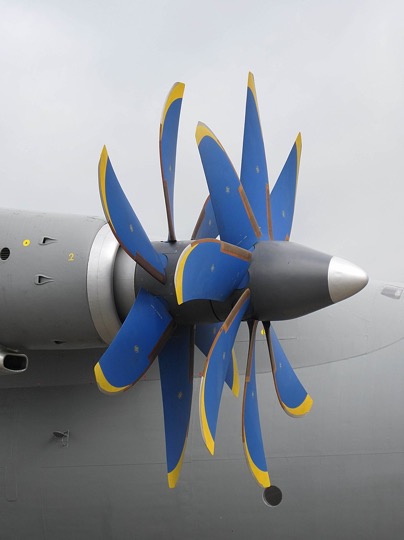
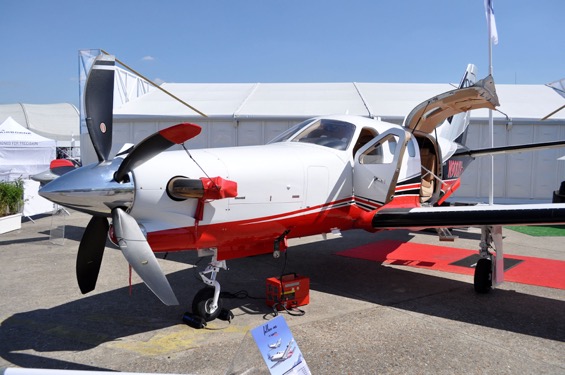
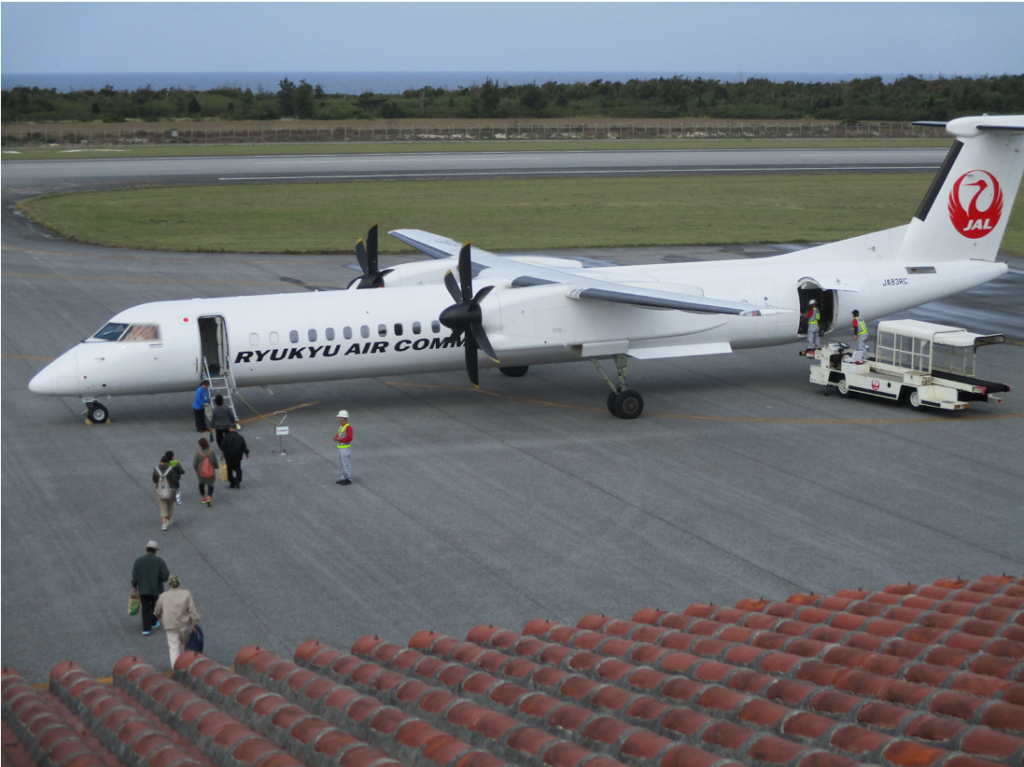
As a side note, in each of the images above you’ll notice that the blades have a slight curve towards the end of each blade tip. There are interesting reasons for this discussed in our article on why some propeller blades are curved.
Final Thoughts on 2 vs. 3 (or More) Bladed Propellers
Most general aviation planes have either a 2-bladed or 3-bladed propeller. If you are considering a propeller replacement or building a home-built aircraft, you may find yourself having to decide how many blades are right for you.
The bottom line is that 2-bladed propellers are longer, louder, more efficient, and less powerful. 3-bladed propellers are shorter, quieter, less efficient, and more powerful.
It’s important to remember that adding more propeller blades typically adds more cost. The difference between a 2-blade and a 3-bladed propeller in acquisition and maintenance cost should definitely not be overlooked.
Weight differences between propellers are another consideration. Propellers with more blades are heavier.
We haven’t even discussed constant-speed propellers. To learn more about this fascinating topic, check out our YouTube video on the topic:
Last but not least, aesthetics are an important consideration. This really explains why many owners of aircraft under 300 horsepower make the switch to a 3-bladed propeller. It also comes down to personal preference whether you prefer the look of a 2-bladed or 3-bladed propeller.
There are some people who simply prefer the look of a 3-bladed propeller and don’t mind losing out on some efficiency and paying more!


